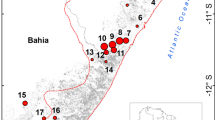Abstract
A series of four transect or strip censuses of primates was carried out in a forest in eastern Colombia where the absolute density of the three diurnal species had been previously calculated during long-term studies. The diurnal species were Alouatta seniculus, Callicebus torquatus,and Cebus apella.Techniques were identical, except for a few variables tested for their effect on the experimental results;these included three different types of detection distances. Variable results were obtained for the two species having the smallest home ranges (A. seniculusand C. torquatus)with the most consistently accurate densities being calculated using the drop in the frequency distribution of sighting distances as a measure of the detection distance. Grossly inflated results were obtained for almost all calculations of C. apelladensity. The stimulus leading to the detection of particular primate groups was usually their vocalizations. Counts of recognized group members were inaccurate and short of the actual number of individuals in each group. Problems of censusing primates are discussed and some recommendations are made with respect to the use of the transect census method.
Similar content being viewed by others
References
Burnham, K. P., Anderson, D. R., and Laake, J. L. (1980). Estimation of density from line transect sampling of biological population.Wildl. Monogr. 72.
Cant, J. G. H. (1978). Population survey of the spider monkey,Ateles geoffroyi at Tikal, Guatamala.Primates 19(3): 525–535.
Defler, T. R. (1981). The density ofAlouatta seniculus in the Llanos Orientales of Colombia.Primates 22: 564–569.
Defler, T. R. (1982). A comparison of intergroup behavior inCebus albifrons andC. apella.Primates 23: 385–392.
Defler, T. R. (1983). Some population characteristics ofCallicebus torquatus lugens (Humboldt, 1812) (Primates: Cebidae) in eastern Colombia.Lozania 38: 1–9.
Defler, T. R. (1984). Contiguous distribution of twoCebus monkey species in El Tuparro National Park, Colombia (in press).
Eisenburg, J. F., and Thorington, R. W., Jr. (1973). A preliminary analysis of a neotropical mammal fauna.Biotr.5: 150–161.
Emlen, J. T. (1971). Population densities of birds derived from transect counts.Auk 88: 323–342.
Freese, C. (1975). A census of non-human primates in Peru. InPrimate Censusing Studies in Peru and Colombia, Pan American Health Organization,World Health Organization, Washington, D.C., pp. 17–41.
Green, K. M. (1978). Primate censusing in northern Colombia: A comparison of two techniques.Primates 13(3): 537–550.
Green, K. M. (1979). A manual for censusing primates (unpublished manuscript).
Hayne, D. W. (1949). An examination of the strip census method for estimating animal populations.J. Wildl. Manag. 13: 145–157.
Janson, C., and Terborgh, J. (1984). Censusing primates in rainforest with reference to the primate community at Cocha Cashu Biological Station, Manu National Park, Peru (in press).
Muckenhirn, N. A., Mortensen, B. K., Vessey, S., Fraser, C. E. O., Singh, B., Heltne, P., Freese, C., and Whitesides, G. (1976). Primate population surveys in Guyana and Bolivia. National Academy of Sciences, Washington, D.C.
National Research Council (NRC) (1981).Techniques for the Study of Primate Population Ecology, National Academy of Sciences, National Academy Press, Washington, D.C.
Neville, M. K., Castro, N., and Marmos, A. (1976). Censusing primate populations in the reserved area of the Pacaya and Samiria Rivers, Department Loreto, Peru.Primates 17: 151–181.
Overton, W. S. (1971). Estimating the numbers of animals in wildlife populations. In Giles, R.H. (ed.),Wildlife Management Techniques, The Wildlife Society, Washington, D.C, pp. 403–456.
Robinette, W. L., Jones, D. A., Gashwiler, J. S., and Aldous, C. M. (1954). Methods for censusing winter-lost deer.Trans. N. Am. Wildl. Conf. 19: 511–525.
Robinette, W. L., Jones, D. A., Gashwiler, J. S., and Aldous, C. M. (1956). Further analysis of method of censusing winter-lot deer.J. Wildl. Manag. 20: 75–78.
Robinette, W. L., Loveless, C. M., and Jones, D. A. (1974). Field tests of strip census methods.J. Wildl. Mang. 38(1): 81–96.
Southwick, C. H., and Cadigan, F. C. (1972). Population studies of Malaysian primates.Primates 13(1): 1–18.
Southwick, C. H., and Siddiqui, M. R. (1966). Population changes of rhesus monkeys (Macaca mulatto) in India, 1959 to 1965.Primates 7(3): 303–314.
Southwick, C. H., Begand, M. A., and Siddiqi, M. R. (1961). A population survey of rhesus monkeys in northern India. II. Transportation routes and forest areas.Ecology 42(4): 698–710.
Struhsaker, T. T. (1975).The Red Colobus Monkey, University of Chicago Press, Chicago, pp. 181–188.
Struhsaker, T. T., Glander, K., Chirivi, H., and Scott, N. J. (1975). A survey of primates and their habitats in northern Colombia. InPrimate Censusing Studies in Peru and Colombia, Pan American Health Organization, World Health Organization, Washington, D.C, pp. 43–78.
Wilson, C. C., and Wilson, W. L. (1974). Methods for censusing forest-dwelling primates. In Kondo, S., Kawai, M., and Ehara, A. (ed.),Contemporary Primatology, 5th Int. Congr. Primatol., Nagoya, S. Karger, Basel.
Yapp, W. B. (1956). The theory of line transects.Bird Study 3: 93–104.
Author information
Authors and Affiliations
Rights and permissions
About this article
Cite this article
Defler, T.R., Pintor, D. Censusing primates by transect in a forest of known primate density. Int J Primatol 6, 243–259 (1985). https://doi.org/10.1007/BF02745499
Received:
Revised:
Issue Date:
DOI: https://doi.org/10.1007/BF02745499




